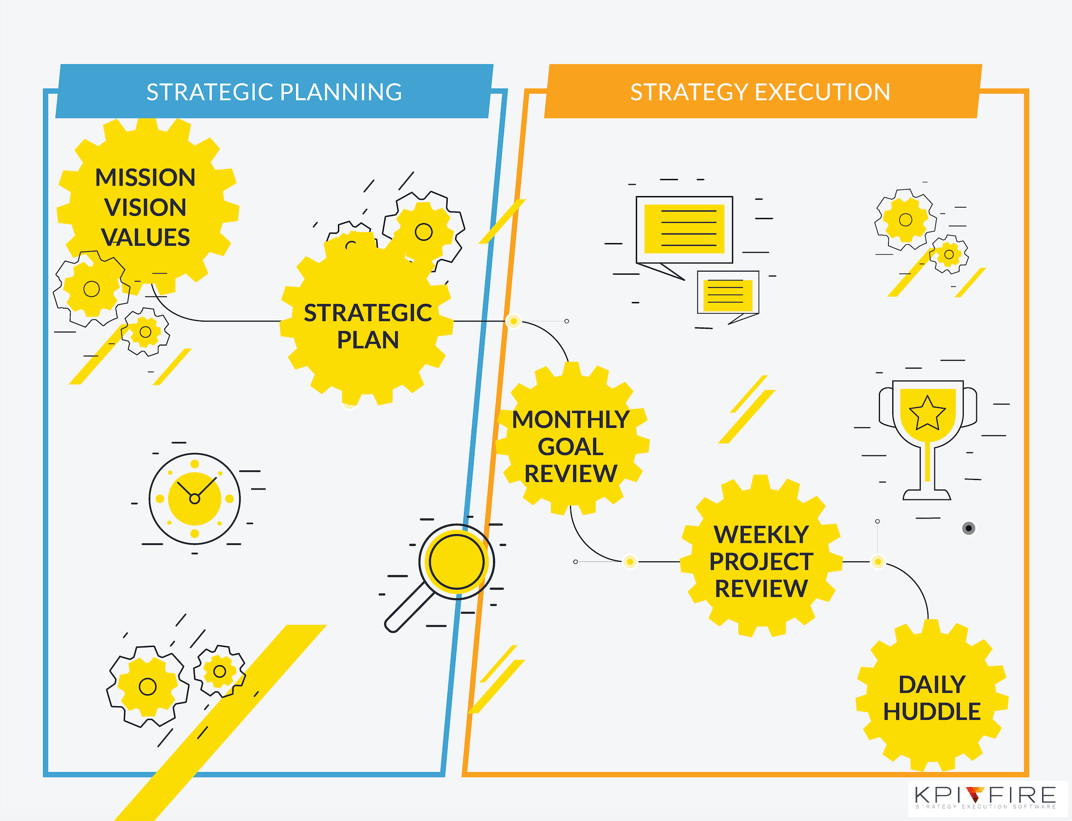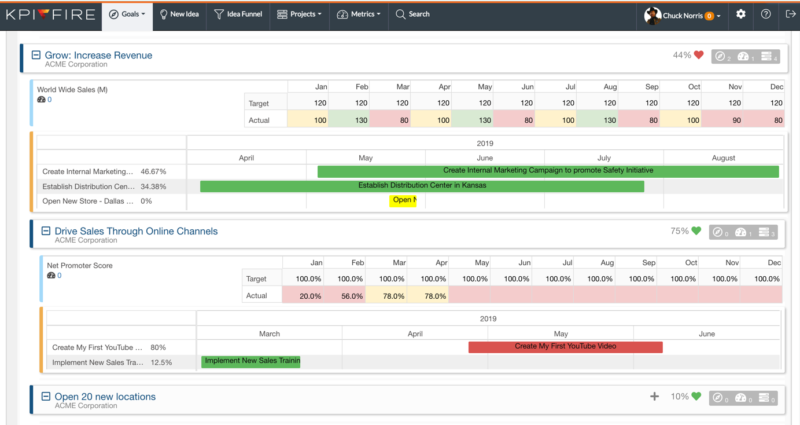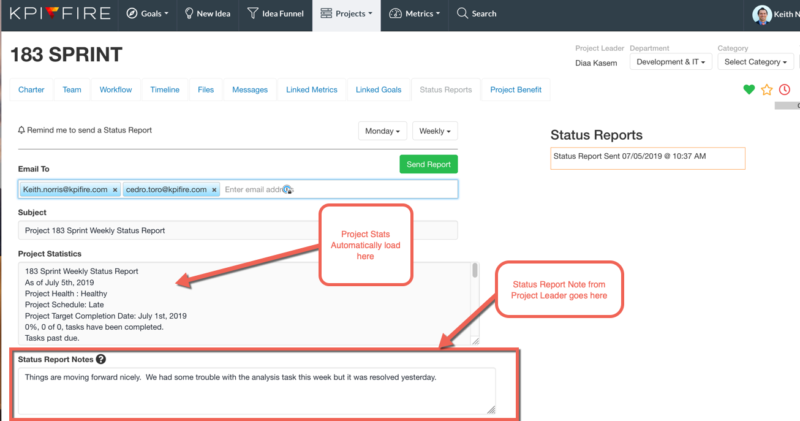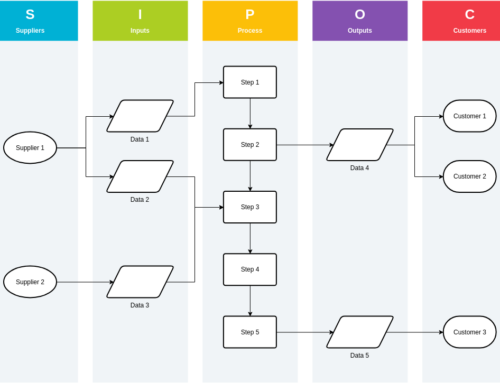What is a Strategy Execution Culture? An organization that can effectively accomplish its most important strategic goals.
Strategy: a preferred method for achieving a desired future state.
Execution: the carrying out or putting into effect of a plan, order, or course of action.
Culture: the way we do things around here
Why would you want a strategy execution culture? Companies with good Strategy Execution can accomplish virtually any objective they set a plan toward and can lead their industries in financial performance, customer satisfaction, product quality, and employee engagement.
Strategy Execution Ritual #1) MVV Session (Mission Vision Values)
Clarify the Mission, Vision, and core Values of your organization. If you haven’t done this yet, this is an excellent place to start in developing your execution culture. Without these in place, every goal you set and every milestone you accomplish is likely to feel like a whiplash experience moving from one seemingly random path to another. A clearly defined, well articulated Mission, Vision, and Core Values statement will help direct the rest of the work that you do.
Tangible Outputs of this Session:
- A one page (or smaller) document that articulates the following:
- Mission: What is our purpose for being?
- Vision: Where do we want to be in the future? (5-10 years)
- Values: What are the boundaries that we will not cross to get there?
- A “culture card” that each your employees can have at their desk displaying the Mission, Vision and Values of the company.
Ideally this work should start with the CEO and be set for the company, but even if you are part of a mid level team, this is an exercise that you can conduct for your specific team. Each team can have their own version of this. If you do have a well defined company MVV, then your team MVV should reflect that or add additional specifics or clarity.
Frequency: The primary work on this should a one-time activity if you really nail it the first time. It should be reviewed frequently and as part of every Annual Strategic Goal Planning session thereafter you should update it as appropriate. This activity can also be done as part of any new team formation as a way of uniting the purpose of the team and establishing a common mindset.
Related topics: How to define your company values
Strategy Execution Ritual #2) Annual Strategic Goal Planning Session
This Annual Strategic Goal Planning session should be done with each one of your teams at every level of the organization. At each level other than your primary leadership team your teams are likely going to be starting with some goals set by the level above. Most teams find that even when the level above them has set the primary goals, there is usually quite a bit of work to translate the “big picture” into meaningful goals for their specific team. The best goals are ones that can focus the energy of a team and unite them in purpose to achieve greatness.
The desired output of this session is a Strategic Plan document. This is an activity that should be completed on an annual basis and should begin with a review of the Mission,Vision, Values as well as a review of the prior years strategic plan and goal accomplishment. If you have a good execution culture, you may be celebrating successes when you review last years plan. If you are like many companies, you might find that you had good ambitions last year but some (or many) of your strategic goals did not really make the progress you wanted to.
The Process:
- Review Mission, Vision, Values. Establish big picture purpose.
- Strategic Thinking: this can take various forms including reviewing prior years plans, reviewing upline goals, SWOT or other Analysis. The objective of this step is both brainstorm possibilities and then to evaluate and narrow the choices.
- Identify Strategic Themes.
- Identify Smart Goals. A good goal format is from X to Y by When.
Tangible Outputs of this Session:
- 1-3 Strategic Goals (per team): Goal Name, Team Owner, Individual Owner, Brief description about the goal and its purpose. Something that can be read by another person inside the organization that would make the objective easily understood.
- 2 Metrics Per Goal: 1 Lag Metric that best measures the success or progress of the goal.1 Lead. Metric that best predicts the success or progress of the goal
- List of Projects with Charter (Initiatives) that need to be accomplished to achieve the Goal. These projects should include a problem/opportunity statement as well as a clearly written summary of the objectives of each project. (Project Charter)
Related Topic: Hoshin Kanri Strategic Planning
Strategy Execution Ritual #3) Monthly Goal Review (1:1)
This is a review session where you pull out the Annual Strategic Plan and Review it with the same team that was responsible for creating it and executing it. The leaders purpose of the review is to reaffirm the importance of the strategic goals, to celebrate progress toward the goal, to become aware of potential issues that could get in the way of accomplishing the goal, and to develop corrective actions that can help get the goal back on track.
Agenda:
- Review each of the goals: (Is this goal still important? Make sure everyone knows it. )
- Review each Metric Updates. Identify status by color. Green (On Track),Yellow (Watch), Red (Corrective action required)
- Review Health of each Project/Initiative: Green (On Track),Yellow (watch), Red (Corrective action required),
- For each required corrective action, create a new assignment
Preparation for this meeting:
- Status update for each goal, or project.
- Update the metrics
- Get Project updates for each project or sub initiative connected to the goal. A detailed review of every project task may not be required. This review should focus on Project Health and Project Charter definition.
Monthly goal reviews can and should be conducted at every level of your organization and should follow your lines of performance accountability reporting. For example: CEO with each VP, VP with each Director, Team Leader with each Team Member.
Ritual #4) Weekly Project Progress Reports
A weekly review should be conducted by each person who owns a Strategic Project. The Project Owner ensures that all of the individual project tasks are on track and the Project Team is accomplishing their assigned tasks. The Project Owner can send out a progress report to the stakeholders each week if the project requires little input & collaboration, but an actual meeting may be required if there are any issues.
Agenda (Complete for each strategic project you are the leader of):
- Review project Charter.
- Is the charter complete & accurate?
- Does the charter still accurately reflect what needs to be done?
- Review Workflow Tab, Review/Update individual task completion status:
- Are the next tasks properly identified?
- Do any tasks need to be marked as completed?
- Does anyone need to be reminded of an important task?
- Update Metrics (if tracking weekly metrics)
- Update Project health [heart icon](Red/Yellow/Green)
- Send Weekly Status Update report to stakeholders.
Who should attend: Teams. This is a Team centric meeting. If you are a member of more than one team, you might have multiple of these meetings to attend each week. To save time, if a particular team has multiple strategic projects you can review them in one standing meeting.
Strategy Execution Ritual #5) Daily Team Huddle (5-15 Min)
This is a daily meeting held at the team level. It should be 5-15 minutes and the agenda of the meeting is simply to share a quick update, communicate wins, or to set up other discussions or meetings that may be required. Attendees to this meeting should stand up so that it does not take longer than 5-15 minutes.
Format (each person) in quick succession:
- What I’m working on.
- What I’ve recently completed (Celebrate Wins!)
- Issues I’m having (may require a separate meeting to go into detail)
Tangible Outputs from Daily Huddle:
-Metric Update: ideally, assign one person to update a single metric to enable accountability.
-Capture Improvement Ideas: These may be ideas today, or may be immediately actionable. Decide which is best.
If your team is tracking daily or weekly metrics as part of a goal, the update number should be shared at this meeting.
Who should attend: Team members of a single operating team
If you would like a software package that can help you implement these rituals into your organization check out KPIFire.com.








